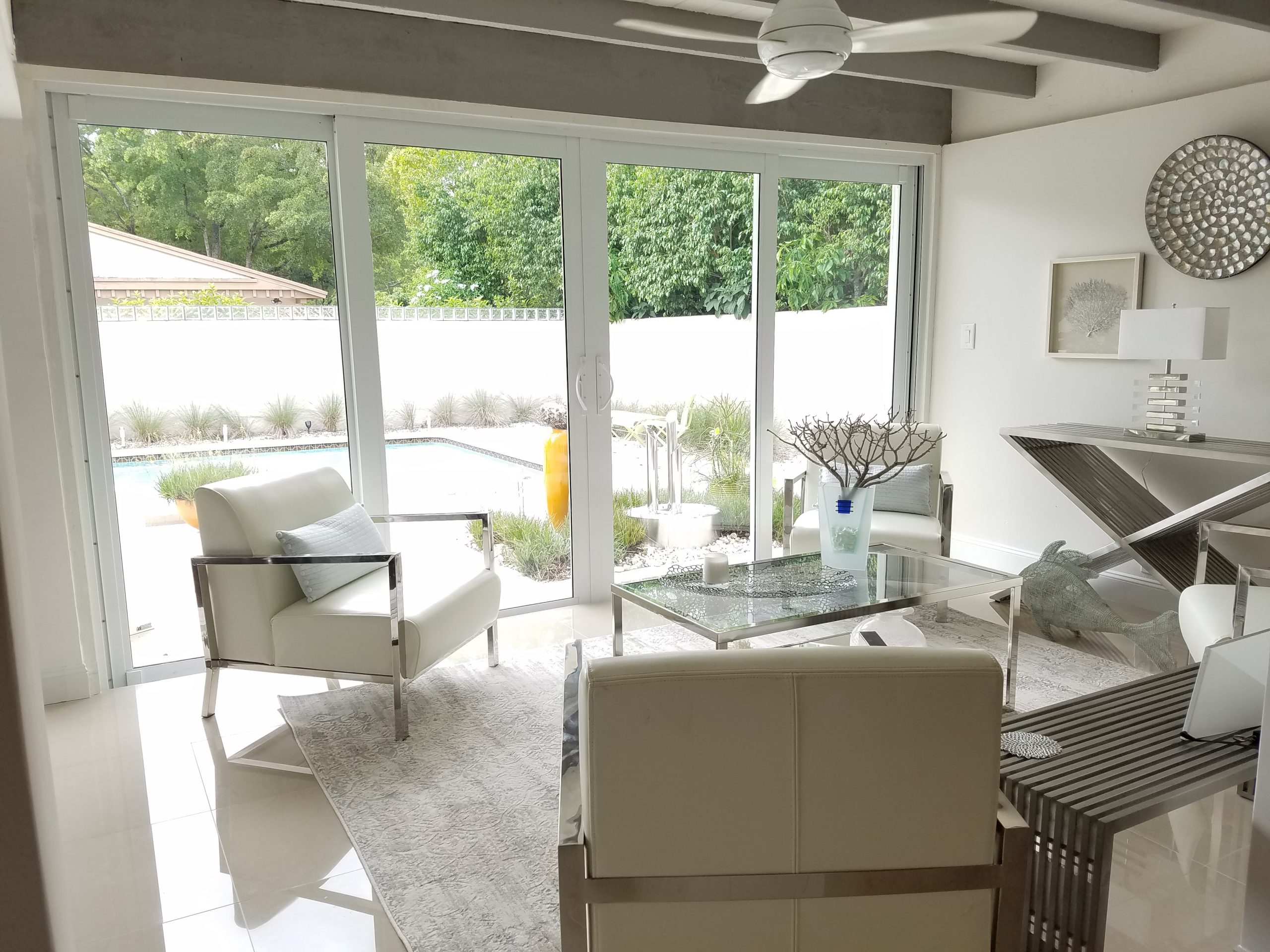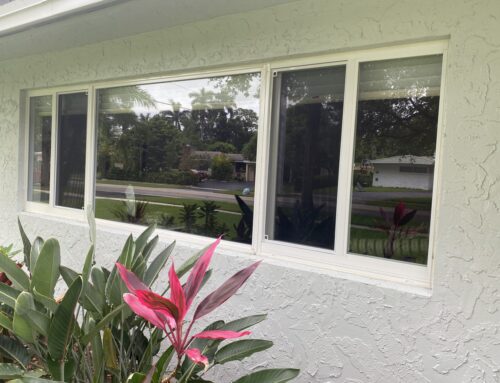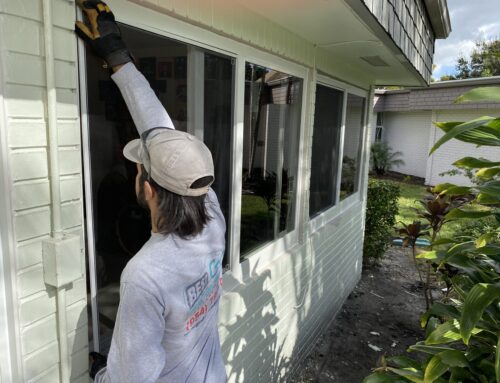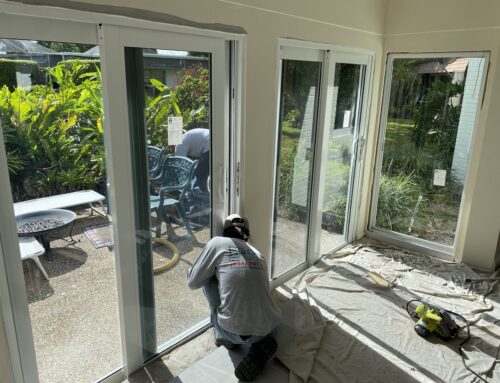Impact windows, also known as hurricane windows, are designed to withstand a Category 5 hurricane, but many other factors come into play when facing a storm. Please note it is advisable to evacuate as directed by local authorities when facing a major hurricane.
Ever since Hurricane Andrew in 1992, Miami-Dade County and Broward County have implemented the strictest building codes in the country to deal with threatening storms. Often, you will hear windows identified as Miami-Dade-approved windows. The code requires windows to have a design pressure (DP) rating of at least +/- 60 to protect against a hurricane. A DP rating measures the strength of a window against winds. Standard residential windows have DP values between 15 and 50. A DP 15 window can withstand winds of roughly 77 mph before shattering, while a DP 50 window can withstand winds up to 173 mph.
Impact windows and glass impact doors are made with impact-resistant laminated glass consisting of two or more clear panes of glass bonded together with a clear plastic-like film (usually polyvinyl butyral) sandwich between two panes. If cracked or broken, the glass fragments will adhere to the plastic interlayer, preventing water, wind, or debris from entering the home. Impact windows and doors generally have heavier frames than regular residential windows.
It is essential that your replacement windows meet the code requirements for your area’s minimum wind speed, exposure, and structural type. Broward and Miami-Dade Counties are located in a High-Velocity Hurricane Zone.
How hurricane windows are tested
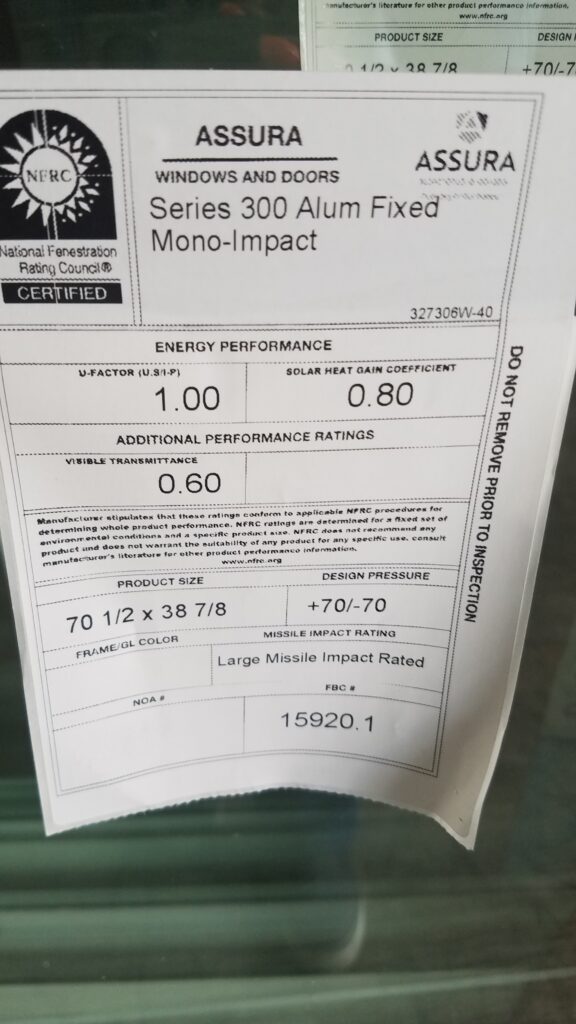
Design Pressure Rating / Wind Load
Building codes require windows to be wind load tested. Wind load rating is the amount of air pressure that can be exerted against the window without causing it to fail. This pressure is measured against the outside of the window (called the positive pressure) and against the inside of the window (the negative pressure). Impact windows are engineered and manufactured to meet a design pressure rating. An independent laboratory tests the window to 150% of the design pressure rating. This is the test pressure rating. The design and test pressure ratings are stated in the pressure per square foot (psf).
Impact Rating
Impact windows are tested to simulate the impact of wind-blown debris during a hurricane. The test involves twice launching a 9-pound, 2×4 piece of lumber at the glass at 50 feet per second, which is considered a “large missile.” To test for “small missiles,” ten 2g steel balls are simultaneously launched at 89mph three separate times.
Hurricane Ratings
The Saffir-Simpson Hurricane Wind Scale is a classification system used to measure and categorize hurricanes based on their wind speed and potential for damage. Understanding this scale is crucial in assessing the severity of a hurricane and determining the necessary evacuation and preparation measures.
Categories of the Saffir-Simpson Scale
The Saffir-Simpson Scale is a classification system that categorizes hurricanes based on their wind speeds and potential for damage. It provides valuable information to help communities prepare and respond to these powerful storms. Let’s explore each category in more detail:
Category 1 Hurricanes
Category 1 hurricanes have wind speeds of 74-95 MPH. While they are considered relatively weak compared to higher categories, they can still pose a threat. These hurricanes have the potential to cause damage to roofs, trees, and power lines. Additionally, storm surge heights typically range between 4-5 feet, which can lead to coastal flooding and erosion.
Category 2 Hurricanes
Category 2 hurricanes have wind speeds of 96-110 MPH. These hurricanes are stronger than Category 1 and can cause more extensive damage. With their increased wind speeds, they have the ability to uproot trees, damage structures, and lead to prolonged power outages. Storm surge heights range between 6-8 feet, posing a significant risk to coastal regions and increasing the potential for flooding.
It is worth noting that categories 1 and 2 are still considered relatively moderate hurricanes. However, their destructive potential should not be underestimated, and appropriate precautions should be taken to ensure the safety of individuals and communities.
Category 3 Hurricanes
Category 3 hurricanes have wind speeds of 111-129 MPH. These hurricanes are classified as major hurricanes and can cause significant damage. With their powerful winds, they have the ability to cause extensive damage to buildings, infrastructure, and vegetation. Storm surge heights can reach 9-12 feet, posing a severe threat to coastal areas and increasing the risk of widespread flooding.
Category 3 hurricanes are often associated with extensive power outages, flooding, and the potential for significant structural damage. As a result, evacuation is typically recommended for individuals in affected areas to ensure their safety and well-being.
Category 4 Hurricanes
Category 4 hurricanes have wind speeds of 130-156 MPH. These hurricanes are considered extremely dangerous and have the potential to cause catastrophic damage. With their intense winds, they can completely destroy buildings, uproot large trees, and lead to widespread power outages. Storm surge heights can exceed 13 feet, posing a major threat to coastal regions and increasing the risk of devastating flooding.
It is crucial to heed evacuation orders for Category 4 hurricanes, as the potential for injury and loss of life is high. These hurricanes can have a long-lasting impact on affected areas and may require significant recovery efforts to rebuild and restore essential services.
Category 5 Hurricanes
Category 5 hurricanes have wind speeds exceeding 157 MPH. These hurricanes are the most severe and have the potential for catastrophic damage. With their extremely powerful winds, they can completely destroy buildings, uproot trees, and cause prolonged power outages. Storm surge heights can reach over 18 feet, posing an extreme threat to coastal areas and increasing the risk of devastating flooding.
When facing a Category 5 hurricane, it is imperative to evacuate immediately. The potential for devastating impacts is high, and individuals should prioritize their safety and follow official guidance. These hurricanes can leave a trail of destruction in their wake, and communities may require extensive support and resources to recover.
Understanding the different categories of hurricanes is essential for preparedness and response efforts. By being aware of the potential impacts associated with each category, individuals and communities can take appropriate measures to protect themselves, mitigate damage, and ensure a swift recovery.
Over the years, the scale has undergone several revisions and refinements to improve its accuracy. Meteorologists and scientists have analyzed data from numerous hurricanes, studying their impact and wind speeds to further enhance the scale’s ability to predict the potential damage caused by these powerful storms.
Home Preparation
There are no guarantees if a major storm hits. Still, if you install impact windows, hurricane-rated entrance doors, an impact-rated garage door, and a new roof attached with hurricane straps, you will ensure your home is always ready if a storm threatens. There are also issues to be concerned about if you are in a flood zone or near the coast where storm surges could cause significant damage. To qualify for discounts on your homeowner’s policy, every opening on your home must have a hurricane-rated product in place, and you should consider flood insurance.
GM Door, Window & Screen has the most affordable solutions for your home remodeling project. We specialize in the installation of hurricane-ready / impact windows, sliding doors, and entrance doors. In business since 1968, we have been family-owned and operated. GM takes your vision and works within your budget to provide the perfect finished product. Upgrade and make your home safe from storms with new doors, windows, shutters, and more. Call today for a free estimate (954) 797-0797.

